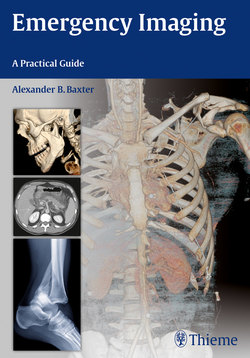Читать книгу Emergency Imaging - Alexander B. Baxter - Страница 16
На сайте Литреса книга снята с продажи.
Оглавление1
1
Int
r
oduc
t
ion t
o Emergenc
y Ima
ging
◆Observing and Interpreting
Some examinations, such as a radiograph of a simple fracture in a long bone, can be appreciated immediately and accurately. Others, especially those involving com-plex anatomic structures such as the hand, wrist, or foot and most cross-sectional ex-aminations, require a structured approach to ensure that all elements of the study have been reviewed. In reality, most radiologists and other observers use a combination of immediate recognition, or “gestalt,” and a mental checklist, and the mix changes with experience. It is much easier to recognize an important finding if one has seen it be-fore, preferably many times before.
Appreciating the significance of an im-aging finding is as important as its recog-nition, and “normality” on a radiograph is a function of many factors, including age, body habitus and composition, radiograph or computed tomography (CT) image qual-ity, and position. Experience and practice leads to both sensitivity in detecting subtle abnormalities and an understanding of whether a finding is truly pathologic.
◆Reporting
The imaging report is the radiologist’s work product. It consists of two major elements: a written description of all observations that support the diagnostic impression and a summary that contains one or several diagnoses and any necessary discussion or recommendations. The format of the report may vary depending on the type of study and the preferences of the radiologist
or their institution, but it should always in-clude the following:
• Body part imaged
• Technique
• Indication and relevant history
• Comparison studies (if any)
• Findings
• Impression
It is important to present one’s findings and conclusions in a clear, organized, and succinct manner. Unfortunately, many re-ports are hobbled by wordiness, jargon, and redundancy.
Reports should be complete, but the ra-tio of “signal to noise” should be as high as possible, especially in the emergency setting. No one has time to wade through excessive, meandering, or unnecessary de-scription of findings not pertinent to the primary goals of the treating emergency physician: acute management, patient disposition, or safe discharge from the emergency department. Although every radiologist will develop a personal style, usually by emulating teachers and col-leagues, application of some basic princi-ples will result in reports distinguished by clarity, brevity, and meaning.
Describe findings anatomically, espe-cially when reporting studies of anatomi-cally complex regions, such as the neck and abdomen. Within this context, try to address the findings relevant to the clinical question early in the report, and note inci-dental findings later.
If many findings—such as multiple fa-cial fractures, intracranial metastases, or enlarged lymph nodes—need to be ac-
